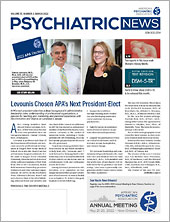The connection between sleep disorders and substance use disorders will be one of several themes addressed by the National Institute on Drug Abuse (NIDA) at APA’s 2022 Annual Meeting in New Orleans. This year’s NIDA research track will also include sessions on noninvasive brain stimulation, advances in treating patients with methamphetamine use disorder, and a lecture by NIDA Director Nora Volkow, M.D., on the social determinants of substance use disorders.
According to the Centers for Disease Control and Prevention (CDC), drug misuse and overdose deaths in the United States reached an all-time high last year. Provisional data released by the CDC suggest that more than 100,000 people died from drug overdoses between May 2020 and April 2021—a nearly 30% increase in overdose deaths from the prior year. Experts have suggested this dramatic rise may be the result of social isolation, job loss, reduced access to support services, and other socioeconomic ramifications of the COVID-19 pandemic.
In her lecture “The Social Determinants of Substance Use Disorders During COVID,” Volkow will describe how NIDA is working to address the roots of the current drug crisis. She will discuss recent studies assessing how to optimally deploy substance use disorder care to disadvantaged groups including people living in rural communities; homeless individuals; and those in prison and jails. Such efforts are needed now more than ever, as COVID-19 continues to spread, including among people with substance use disorders in prisons and homeless shelters.
In addition to describing the social and structural challenges faced by those with substance use disorders, Volkow’s lecture will explore targeted prevention strategies and provide updates on new medications and formulations to help treat opioid use disorder and overdoses.
The other seven sessions in this year’s NIDA track include:
•
Promoting Neuroplasticity to Treat Psychiatric Disorders and Addiction (May 21, 4 p.m.-5:30 p.m.). Both ketamine and psychedelic drugs such as psilocybin are generating buzz as antidepressant agents. Some data suggest psychedelics may also be effective therapies for reducing symptoms in people with substance use disorders. This session will explore the current state and future of psychedelic research in addiction, especially the purported ability of these drugs to promote neuroplasticity (help the brain to restore healthy neural connections).
•
Leveraging Large Neuroimaging Studies to Elucidate Socioeconomic Impacts on Neurocognitive Development (May 22, 10:30 a.m.-noon). Gayathri Dowling, Ph.D., director of the nationwide Adolescent Brain and Cognitive Development (ABCD) Study, will chair this session on how neuroimaging data are helping researchers to better understand how early life adversity affects the developing brain. Session panelists will highlight some of the latest neuroimaging data from both the ABCD Study and IMAGEN (a European imaging study exploring adolescent brain development).
•
NIDA Clinical Trial Network: Research Updates and Future Directions in the Treatment of Methamphetamine Use Disorder (May 22, 1:30 p.m.-3 p.m.). The rates of methamphetamine use and methamphetamine use disorder in the United States have risen dramatically in recent years. There are currently no FDA-approved treatments for methamphetamine use disorder, but panelists in this session will highlight three promising therapeutic candidates being tested in clinical trials: injectable naltrexone combined with oral bupropion, transcranial magnetic stimulation, and ketamine.
•
Neurobiology of Interrelationship Between Sleep and Substance Use Disorders (May 23, 10:30 a.m.–noon). Studies show that substance use disorders and sleep disorders are connected: Substance use disrupts the quality and duration of sleep, while poor sleep increases feelings of craving and impulsivity which can heighten substance use. What are the biological mechanisms that drive this connection? The presenters in this session will discuss some of the latest preclinical research findings on how opioids and other substances disrupt the delicate balance between sleep and arousal.
•
New Frontiers Targeting Neural Circuit Function to Develop Non-invasive Brain Stimulation Treatment Strategies for Substance Use Disorders (May 23, 1:30 p.m.-3 p.m.). This symposium will feature a group of NIDA-funded early career scientists mapping out the neural circuits involved with reward seeking, craving, and other behaviors that drive problematic substance use. The presenters will discuss how their work may identify new targets for noninvasive brain stimulation and lead to more effective protocols tailored to individual patient’s symptoms.
•
Data Science Tools to Predict, Prevent, and Treat Substance Use Disorders (May 24, 10:30 a.m.-noon). With the continued growth of both electronic medical data and artificial intelligence/machine learning programs, the promise of using “big data” to improve medicine is closer than ever. This symposium will explore opportunities and challenges that come with leveraging big data sets as they relate to substance use disorders and related conditions.
•
Pipe Dreams: The Role of Sleep in the Etiology and Treatment of Substance Use Disorders (May 24, 1:30 p.m.-3 p.m.). As a companion to the symposium on the neurobiology of sleep and substance use disorders, this session will explore how sleep disorders contribute to the etiology, clinical presentation, and treatment of patients with a substance use disorder. The presenters will describe two sleep-associated medication classes currently in development for substance use disorders: dual orexin antagonists and fatty acid amide hydrolase (FAAH) inhibitors. ■
Volkow’s lecture, “The Social Determinants of Substance Use Disorders During COVID,” will be held Saturday, May 21, from 1:30 p.m. to 3 p.m.

